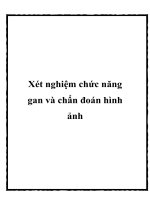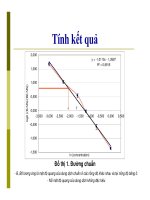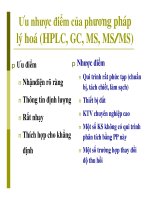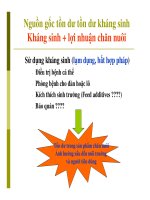bài giảng tiếp cận xét nghiệm chức năng gan thận
Bạn đang xem bản rút gọn của tài liệu. Xem và tải ngay bản đầy đủ của tài liệu tại đây (685.13 KB, 25 trang )
<span class="text_page_counter">Trang 1</span><div class="page_container" data-page="1">
Faculty of Traditional Medicine
<b>University of Medicine and Pharmacy</b>
<b>Tiếp cận tăng men gan</b>
ThS. Võ Thanh Phong
</div><span class="text_page_counter">Trang 2</span><div class="page_container" data-page="2"><b>Phân bố men gan</b>
AST: cơ tim, cơ vân, cơ trơn, não,
thận
</div><span class="text_page_counter">Trang 3</span><div class="page_container" data-page="3">Faculty of Traditional Medicine
<b>Phân bố men gan</b>
Source: Woreta, Tinsay A. and Alqahtani, Saleh A. (2014), "Evaluation of abnormal liver
<i>tests", Medical Clinics. 98(1), pp. 1-16.</i>
Hoại tử tế bào gan ở quanh TM trung tâm có tăng ALT<AST
</div><span class="text_page_counter">Trang 4</span><div class="page_container" data-page="4"><b>Chuyển hóa AST, ALT</b>
•AST, ALT được dị hóa tại lưới nội chất của tế bào gan
•Thời gian bán hủy:
oAST: 17±5 giờ
oALT: 47±10 giờ
• Trong pha hồi phục sau hoại tử TB gan, ALT>AST
</div><span class="text_page_counter">Trang 5</span><div class="page_container" data-page="5">Faculty of Traditional Medicine
<b>Tăng men gan thực sự hay khơng?</b>
•ALT 29-33 IU/L ở nam, 19-25 IU/L ở nữ
•ALT bình thường khơng loại trừ bệnh gan
•Khoảng tham chiếu AST, ALT khác nhau giữa các lab
•Mức độ tăng:
oTăng biên: <2 ULN
oTăng nhẹ: 2-5 ULN
oTăng trung bình: 5-15 ULN
oTăng cao: >15 ULN
oTăng rất cao: ALT>10,000 U/L
Source: Kwo, Paul Y., Cohen, Stanley M., and Lim, Joseph K. (2017), "ACG clinical
<i>guideline: evaluation of abnormal liver chemistries", American Journal of Gastroenterology. </i>
112(1), pp. 18-35.
</div><span class="text_page_counter">Trang 6</span><div class="page_container" data-page="6">Tăng men gan nhẹ
Bệnh sử, khámDùng thuốc/rượu
<b>Cịn tăng</b>
Định hướng ngun nhân
Ngưng thuốc/rượuXN lại
Độ bão hồ transferrinFerritin tăng
Tìm đột biến HFE nếu độ bão hịa
trans>45%Ngun nhân ngồi
Có nguy cơ nhiễm các virus viêm gan
Tìm HAV, HEV, HBV, HCV
Nữ trung niên, có bệnh tự miễn
ANA, ASMA, anti-LKM và IgG
-Chuyển hóa đồng, ceruloplasmin-Alpha1-antitrypsin
-Kháng thể transglutaminase
Gan nhiễm mỡ không do rượu (NAFLD)
Sinh thiết gan vs lặp lại XN
</div><span class="text_page_counter">Trang 7</span><div class="page_container" data-page="7">Faculty of Traditional Medicine
<b>Tăng transferase ngoài gan</b>
•Nhồi máu cơ tim
•Bệnh cơ
oBẩm sinh: bất thường chuyển hóa, teo cơ
oMắc phải: viêm cơ, hoại tử cơ do chấn thương, chuột rút
•Cường giáp, nhược giáp
Source: Malakouti, Mazyar, et al. (2017), "Elevated liver enzymes in asymptomatic
<i>patients–what should I do?", Journal of clinical and translational hepatology. 5(4), p. 394.</i>
</div><span class="text_page_counter">Trang 8</span><div class="page_container" data-page="8"><b>Thuốc gây tăng transferase</b>
<b>Kháng sinhPenicillin tổng hợpCiprofloxacin</b>
<b>Chống động kinh</b>CarbamazepinePhenytoin
NSAIDsCorticoid
</div><span class="text_page_counter">Trang 9</span><div class="page_container" data-page="9">Faculty of Traditional
Source: (*)Lok AS, Zoulim F, Dusheiko G, Ghany MG. Hepatitis B cure: from discovery to
<i>regulatory approval. J Hepatol 2017;67:847–61. (†)EASL 2017 Clinical Practice Guidelines on the management of hepatitis B virus infection. J Hepatol 2017;67:370-98.</i>
</div><span class="text_page_counter">Trang 10</span><div class="page_container" data-page="10"><b>Biện luận kết quả test HBV</b>
2. Test không đủ nhạy do anti-HBs quá thấp
3. Anti-HBc dương giả
4. Nhiễm mạn với HBSAg dưới ngưỡng phát hiện
</div><span class="text_page_counter">Trang 11</span><div class="page_container" data-page="11">Faculty of Traditional Medicine
<b>University of Medicine and Pharmacy</b>
<b>Tiếp cận tăng bilirubin</b>
ThS. Võ Thanh Phong
</div><span class="text_page_counter">Trang 12</span><div class="page_container" data-page="12"><b><20% trực tiếp</b>
Tăng bilirubin
ALT, AST ALT /┴ Tăng bilirubin đơn độc
Tìm tán huyết
Bất thường CN gan
ALP GGT, 5’NT
Siêu âm
-Check thuốc-Kháng thể kháng
ty thể
-Xem xét sinh thiết
-Hình ảnh học-ERCP
<b>>20% trực tiếp</b>
HC Gilbert
HC Dubin-JohnsonHC Rotor
Tiếp cận tăng men gan
</div><span class="text_page_counter">Trang 13</span><div class="page_container" data-page="13">Faculty of Traditional Medicine
<b>Tăng ALP ngoài gan</b>
Bệnh Paget
K di căn xươngLymphoma
Source: Kwo, Paul Y., Cohen, Stanley M., and Lim, Joseph K. (2017), "ACG clinical
<i>guideline: evaluation of abnormal liver chemistries", American Journal of Gastroenterology. </i>
112(1), pp. 18-35.
</div><span class="text_page_counter">Trang 14</span><div class="page_container" data-page="14">Faculty of Traditional Medicine
<b>University of Medicine and Pharmacy</b>
<b>Tiếp cận tiểu máu</b>
ThS. Võ Thanh Phong
</div><span class="text_page_counter">Trang 15</span><div class="page_container" data-page="15">Faculty of Traditional Medicine
<b>Phân biệt nguồn gốc tiểu máu</b>
<b>Cầu thuậnNgoài cầu thận</b>
Source: Vedula, Ramya and Iyengar, Arpana A. (2020), "Approach to diagnosis and
<i>management of hematuria", The Indian Journal of Pediatrics, pp. 1-7.</i>
</div><span class="text_page_counter">Trang 16</span><div class="page_container" data-page="16"><b>Phân biệt nguồn gốc tiểu máu</b>
<b>Cầu thận</b>
1.Viêm cầu thận nhiễm trùng/hậu nhiễm2.Bệnh thận IgA
3.Viêm cầu thận tăng sinh màng đáy
4.Viêm thận Schönlein
Henoch-5.Lupus6.HC Alport
7.HC móng xương bánh chè8.Bệnh dày màng đáy
9.HC Good Pasture
<b>Ngồi cầu thận</b>
1.Sỏi thận
2.Huyết khối tĩnh mạch thận3.Thông động tĩnh mạch thận4.U Wilm
5.Tăng calci máu
6.Thuốc: NSAIDs, Cyclophosphamide, kháng đông
7.Viêm bàng quang8.Chấn thương9.HC Manchaussen
</div><span class="text_page_counter">Trang 17</span><div class="page_container" data-page="17">Siêu âm bụngSiêu âm doppler
CT scanCấy nước tiểu
Tỷ lệ calcium/creatinine <0.2 mg/mg
Máu (-), HC (-)
HC dị dạng, trụ HC
Creatinine máuC3, C4
ASLOAlbuminACR, PCR
Source: Vedula, Ramya and Iyengar, Arpana A. (2020), "Approach to diagnosis and
<i>management of hematuria", The Indian Journal of Pediatrics, pp. 1-7.</i>
<b>C3 thấp:</b>
-Viêm bang quang-Tăng calcium máu-Sỏi thận
-U Wilms
-Huyết khối TM thận-Bệnh thận đa nang
<b>C3 bình thường:</b>
-Viêm thận Henoch-Schonlein-Bệnh thận IgA
-Viêm mạch máu nhỏ-Tán huyết do ure máu cao-Dày màng đáy
-HC Good Pasture
Tăng sắc tố do thuốc/ăn uống
</div><span class="text_page_counter">Trang 19</span><div class="page_container" data-page="19">Faculty of Traditional Medicine
<b>Typical course of symptoms and laboratory changes in poststreptococcal glomerulonephritis. </b>
<b>René G. VanDeVoorde III Pediatrics in Review 2015;36:3-13</b>
<small>©2015 by American Academy of Pediatrics</small>
</div><span class="text_page_counter">Trang 20</span><div class="page_container" data-page="20"><b>Nguyên nhân thay đổi màu sắc nước tiểu</b>
<b>ThuốcThức ănChất khác</b>
Củ dền
BlackberriesBlueberriesB-caroteneĐại hoàngCà rốtĐậu favaNha đam
Màu thực phẩm
Phenylketon niệuTyrosinosis
Tăng bilirun niệuHemoglobin niệuMyoglobin niệu
</div><span class="text_page_counter">Trang 21</span><div class="page_container" data-page="21">Faculty of Traditional
Tiểu máu vi thể
Protein niệu (-)
Lặp lại mỗi tuần x 2 tuần
Creatinine huyết thanhPCR/ACR
Protein niệu < 4 mg/h/m2PCR <0.2
Lặp lại sau 2-3 tuầnCòn tiểu máu
Loại trừ nhiễm trùng tiểuLoại trừ tăng calcium niệu
Sỏi niệu
Source: Vedula, Ramya and Iyengar, Arpana A. (2020), "Approach to diagnosis and
<i>management of hematuria", The Indian Journal of Pediatrics, pp. 1-7.</i>
Còn tiểu máuProtein niệu (+)
Tiền căn gia đình tiểu máuPhù/THA/Creatinine tăng
Protein niệu >4 mg/h/m2PCR>0.2
-Chuyển chuyên khoa thận-Sinh thiết thận
-Bệnh di truyền: HC Alport, bệnh dày màng đáy
</div><span class="text_page_counter">Trang 22</span><div class="page_container" data-page="22">Faculty of Traditional Medicine
<b>University of Medicine and Pharmacy</b>
<b>Tiếp cận tiểu đạm</b>
ThS. Võ Thanh Phong
</div><span class="text_page_counter">Trang 23</span><div class="page_container" data-page="23">Faculty of Traditional Medicine
<b>Các yếu tố ảnh hưởng XN đạm niệu</b>
<b>(+) giả(-) giảTiểu đạm sinh lý</b>
Mất nước
Nhiễm trùng tiểuTiểu máu
<i>Source: Snyder, Samuel and John, Jones Sam (2014), "Workup for proteinuria", Primary </i>
<i>Care: Clinics in Office Practice. 41(4), pp. 719-735.</i>
</div><span class="text_page_counter">Trang 24</span><div class="page_container" data-page="24">








